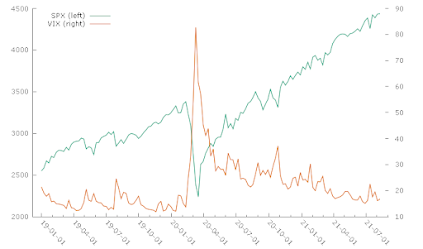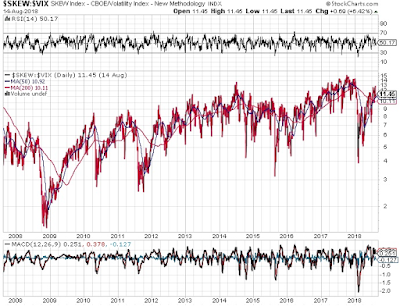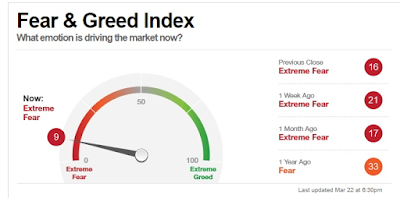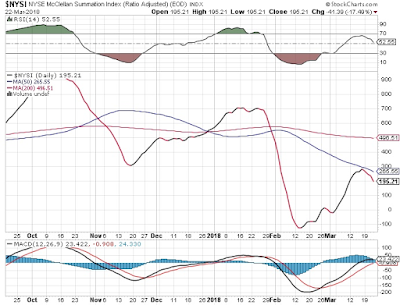There is quite a bit of underperformance in Indian market volatility compared to US market volatility since the COVID-19 crash as indicated by the jaws gap below. This should resolve soon with an upcoming spike in Indian market volatility and a significant fall in the Nifty Index.
About
Ahead of the Curve provides you with analysis and insight into today's global financial markets. The latest news and views from global stock, bond, commodity and FOREX markets are discussed. Rajveer Rawlin is a PhD and received his MBA in finance from the Cardiff Metropolitan University, Wales, UK. He is an avid market watcher having followed capital markets in the US and India since 1993. His research interests includes areas of Capital Markets, Banking, Investment Analysis and Portfolio Management and has over 20 years of experience in the above areas covering the US and Indian Markets. He has several publications in the above areas. The views expressed here are his own and should not be construed as advice to buy or sell securities.
Featured post
Time Series Analysis with GRETL
This video shows key time-series analyses techniques such as ARIMA, Granger Causality, Co-integration, and VECM performed via GRETL. Key dia...

Showing posts with label vix. Show all posts
Showing posts with label vix. Show all posts
Friday 29 April 2022
Jaws GAP - India Vix vs US Vix
Labels:
india vix,
nifty,
spx,
vix,
volatility
I have over 27 years of experience tracking capital markets across the globe, I write about financial markets and teach MBA students financial markets and investing
Wednesday 11 August 2021
Inter Market Divergences
With the stock markets hitting new highs some inter-market divergences have started to appear. Let's take a look at a few of them. The first chart looks at the SPX versus the Transports. You can see the marked divergence in the last few months with transports not confirming new highs in the SPX:
Taking a look at SPX vs Crude shows a smaller divergence that has developed recently:
Lastly, the SPX vs VIX chart reveals the VIX not making new lows for new highs in the SPX:
While these divergences may not matter with central banks flooding the markets with liquidity, once the liquidity shows signs of reversing, they may prove useful in determining what lies ahead.
Labels:
audjpy,
crude,
gold,
spx,
stock market,
transports,
vix
I have over 27 years of experience tracking capital markets across the globe, I write about financial markets and teach MBA students financial markets and investing
Wednesday 27 March 2019
Indicators that Matter
There is a plethora of indicators to track while evaluating financial markets. Here are some important ones:
1) The Chinese Yuan:
The Chinese Yuan is often a proxy for the risk on trade. Periods of strength in the Chinese Yuan as seen in the last 3 months, have often been accompanied by up moves in risk assets such as stocks, commodities and emerging market currencies:
source:investing.com

2) The S and P 500 Price to Sales Ratio:
This is a key valuation measure and price to sales ratios greater than 2 have often symbolized over valuation while ratios lower than 1 have produced undervalued buy opportunities:
source: multpl.com

3) The Yield Curve:
The yield curve is a very reliable economic indicator and an inverted yield curve like we have now has often been followed by recessions or periods of rapidly slowing growth, while an upward sloping yield curve is often indicative of an expanding economy:
source: ETF Trends

4) CNN Money's Fear and Greed Indicator:
This is a sentiment indicator which is a combination of several sentiment indicators and indicates whether market participants are fearful or greedy:
source: CNN Money

5) The Skew Vix Ratio:
This indicator is another sentiment indicator and values below 5 tend to mark panic bottoms while values above 15 tend to mark complacent tops. This ratio has been making lower highs and lower tops of late suggesting that there may be one more panic bottom in the not too distant future:
source: Stock Charts

1) The Chinese Yuan:
The Chinese Yuan is often a proxy for the risk on trade. Periods of strength in the Chinese Yuan as seen in the last 3 months, have often been accompanied by up moves in risk assets such as stocks, commodities and emerging market currencies:
source:investing.com
2) The S and P 500 Price to Sales Ratio:
This is a key valuation measure and price to sales ratios greater than 2 have often symbolized over valuation while ratios lower than 1 have produced undervalued buy opportunities:
source: multpl.com
3) The Yield Curve:
The yield curve is a very reliable economic indicator and an inverted yield curve like we have now has often been followed by recessions or periods of rapidly slowing growth, while an upward sloping yield curve is often indicative of an expanding economy:
source: ETF Trends
4) CNN Money's Fear and Greed Indicator:
This is a sentiment indicator which is a combination of several sentiment indicators and indicates whether market participants are fearful or greedy:
source: CNN Money
5) The Skew Vix Ratio:
This indicator is another sentiment indicator and values below 5 tend to mark panic bottoms while values above 15 tend to mark complacent tops. This ratio has been making lower highs and lower tops of late suggesting that there may be one more panic bottom in the not too distant future:
source: Stock Charts
Labels:
fear and greed,
price to sales,
skew,
vix,
yield curve,
yuan
I have over 27 years of experience tracking capital markets across the globe, I write about financial markets and teach MBA students financial markets and investing
Thursday 16 August 2018
Why a Massive Selloff in Risk Assets Could be Just a Few Days Away?
First market breadth is diverging with the New 52 week high low indicator not confirming the recent retest of highs in the S and P 500:
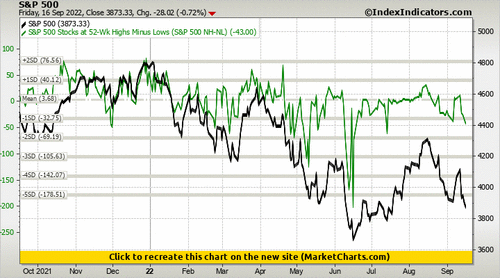
High beta segment of the market such as the Nasdaq is beginning to under perform the broader market much like in 2000:

The Skew Vix ratio as shown on stockcharts has spiked into double digits recently suggesting high tail risk, which is often a precursor to rising volatility and a risk off trade set up:
All this as we are in the middle of an emerging market currency crisis much like in 1998 unsupported by a tightening FED:

High beta segment of the market such as the Nasdaq is beginning to under perform the broader market much like in 2000:

The Skew Vix ratio as shown on stockcharts has spiked into double digits recently suggesting high tail risk, which is often a precursor to rising volatility and a risk off trade set up:
All this as we are in the middle of an emerging market currency crisis much like in 1998 unsupported by a tightening FED:
Emerging markets currencieshttps://t.co/iMzAOoBsZ4 pic.twitter.com/1f4DfSdl1e— Chart of the day (@macrovaluechart) August 16, 2018
Quantitative Tightening Update (June 2018) – 5 Fed Charts https://t.co/IvFzZqBq2c via @seeitmarket— Stéphane Collot (@stephanecollot) August 16, 2018
Labels:
currency crisis,
emerging market currency crisis,
fed,
market breadth,
nasdaq,
skew,
spx,
vix,
volatility
I have over 27 years of experience tracking capital markets across the globe, I write about financial markets and teach MBA students financial markets and investing
Friday 23 March 2018
Stock Market Panic Just Beginning?
Markets have been taking a turn for the worse on fears of a global trade war. A look at the Fear and Greed Index computed by CNNMoney shows that investor sentiment is hitting record lows:
However the Vix is yet to take out the February highs and suggests that there is no major panic yet:
Also the NYSE McClellan Summation Index (courtesy stockcharts) has just begun breaking down again following the recent rally and has more room to fall suggesting more selling ahead:
Taken together we probably are headed for more selling and panic that should take us a lot lower to the major break out zone of the S and P 500 near 2400 first before any relief rallies occur.
However the Vix is yet to take out the February highs and suggests that there is no major panic yet:
Also the NYSE McClellan Summation Index (courtesy stockcharts) has just begun breaking down again following the recent rally and has more room to fall suggesting more selling ahead:
Taken together we probably are headed for more selling and panic that should take us a lot lower to the major break out zone of the S and P 500 near 2400 first before any relief rallies occur.
Labels:
fear and greed,
investor sentiment,
spx,
stock market,
stock market crash,
stocks,
vix
I have over 27 years of experience tracking capital markets across the globe, I write about financial markets and teach MBA students financial markets and investing
Saturday 10 March 2018
Market Signals for the US stock market S and P 500 Index and Indian Stock Market Nifty Index for the Week beginning March 12
|
Indicator
|
Weekly
Level / Change
|
Implication
for
S
& P 500
|
Implication
for Nifty*
|
|
S
& P 500
|
2787, 3.54%
|
Bullish
|
Bullish
|
|
Nifty
|
10227, -2.21%
|
Neutral
**
|
Bearish
|
|
China
Shanghai Index
|
3307, 1.62%
|
Bullish
|
Bullish
|
|
Gold
|
1324, 0.05%
|
Neutral
|
Neutral
|
|
WTIC
Crude
|
62.04, 1.29%
|
Bullish
|
Bullish
|
|
Copper
|
3.14, 0.37%
|
Neutral
|
Neutral
|
|
Baltic
Dry Index
|
1201, 0.42%
|
Neutral
|
Neutral
|
|
Euro
|
1.2307, -0.09%
|
Neutral
|
Neutral
|
|
Dollar/Yen
|
106.77, 0.98%
|
Bullish
|
Bullish
|
|
Dow
Transports
|
10740, 3.94%
|
Bullish
|
Bullish
|
|
High
Yield (ETF)
|
36.09, 0.25%
|
Neutral
|
Neutral
|
|
US
10 year Bond Yield
|
2.89%, 1.30%
|
Bearish
|
Bearish
|
|
Nyse
Summation Index
|
164, 1023.97%
|
Bullish
|
Neutral
|
|
US
Vix
|
14.64, -25.27%
|
Bullish
|
Bearish
|
|
Skew
|
128
|
Neutral
|
Neutral
|
|
20
DMA, S and P 500
|
2714, Above
|
Bullish
|
Neutral
|
|
50
DMA, S and P 500
|
2742, Above
|
Bullish
|
Neutral
|
|
200
DMA, S and P 500
|
2571, Above
|
Bullish
|
Neutral
|
|
20
DMA, Nifty
|
10420, Below
|
Neutral
|
Bearish
|
|
50
DMA, Nifty
|
10606, Below
|
Neutral
|
Bearish
|
|
200
DMA, Nifty
|
10140, Above
|
Neutral
|
Bullish
|
|
India
Vix
|
14.52, 3.22%
|
Neutral
|
Bearish
|
|
Dollar/Rupee
|
64.93, -0.39%
|
Neutral
|
Neutral
|
|
Overall
|
S
& P 500
|
Nifty
|
|
|
Bullish
Indications
|
10
|
6
|
|
|
Bearish
Indications
|
1
|
6
|
|
|
Outlook
|
Bullish
|
Neutral
|
|
|
Observation
|
The
S and P 500 rallied and the Nifty fell last week. Indicators are mixed.
The
markets have made important tops. Time to watch those stops.
|
||
|
On
the Horizon
|
New Zealand –
GDP, China – Industrial production,
Euro Zone – German ZEW economic
sentiment, CPI, Switzerland – SNB rate
decision, U.S – CPI, Retail sales,
Oil inventories, Canada – Poloz
speech
|
||
|
*Nifty
|
India’s
Benchmark Stock Market Index
|
||
|
Raw
Data
|
Courtesy
Google finance, Stock charts, investing.com
|
||
|
**Neutral
|
Changes less than 0.5% are considered
neutral
|
Image from marketwatch.com
The S and
P 500 rallied and the Nifty sharply under performed last week. Indicators are mixed
for the upcoming week. Quantitative tightening by the FED is yet to be priced
in fully. The markets are still trading well over 3 standard deviations above
their long term averages from which corrections usually result. Divergences in
high yield and surging bond yields are flashing warning signs. An interest rate
shock can’t be ruled out. Indian market volatility is still below US market
volatility so there is complacency and some catch up left on the down side. The
critical levels to watch are 2800 (up)
and 2775 (down) on the S & P
and 10300 (up) and 10150 (down) on
the Nifty. A significant breach of
the above levels could trigger the next big move in the above markets. You can
check out last week’s report for a comparison. Love your thoughts and feedback.
Labels:
baltic dry index,
bearish,
bond yield,
bullish,
china,
copper,
euro,
gold,
investing,
nifty,
nyse,
oil,
rupee,
S and P 500,
stock market,
stock signals,
trading,
transports,
vix,
yen
I have over 27 years of experience tracking capital markets across the globe, I write about financial markets and teach MBA students financial markets and investing
Subscribe to:
Posts (Atom)
World Indices
Live World Indices are powered by Investing.com
Market Insight
-
Mutual Orders Of Protection: Do They Harm Or Protect? - Mutual domestic violence is very rare, and wrongful mutual restraining orders put the real victim of abuse at risk48 minutes ago
-
-
The Jobless Numbers That The Government Gives Us Are So Fake - How it is possible that initial claims for jobless benefits have been exactly the same for five of the past six weeks? As Jim Blanco has pointed out, th...2 hours ago
-
-
Market Talk – April 19, 2024 - ASIA: The major Asian stock markets had a mixed day today: NIKKEI 225 decreased 1,011.35 points or -2.66% to 37,068.35 Shanghai decreased 8.96 points or ...3 hours ago
-
Three Stocks: Netflix, Super Micro Computer, and American Express - Three Stocks: Netflix, Super Micro Computer, and American Express Netflix Netflix (NFLX) shares are having their worst day in more than a year after the co...3 hours ago
-
S&P 500 PE Ratio - *Current S&P 500 PE Ratio:* 26.96 -0.24 (-0.88%) 4:00 PM EDT, Fri Apr 193 hours ago
-
Duncker Streett & Co. Inc. Acquires 245 Shares of Visa Inc. (NYSE:V) - Duncker Streett & Co. Inc. increased its holdings in shares of Visa Inc. (NYSE:V – Free Report) by 2.0% during the fourth quarter, according to the company...4 hours ago
-
Living on Uneasy Street - *It's nice to anticipate sunny weather, but it's a good idea to carry an umbrella just in case the forecasts prove overly optimistic. * *Yes, the market w...5 hours ago
-
Friday links: not taking enough risk - Markets - TIPS are on sale. Time to buy. (morningstar.com) - Two reasons why yields are higher this year. (carsongroup.com) - The stock-bond cor...6 hours ago
-
Chart of the Day: Retail Sales, Unemployment & Inflation - Have you missed any of Mike Carr's charts in Money & Markets Daily? See his recent coverage on retail sales, unemployment and inflation. The post Chart o...8 hours ago
-
MiB: Ashish Shah, CIO, Public Investing, Goldman Sachs Asset Management - This week, we speak with Ashish Shah, Chief Investment Officer, Public Investing, Goldman Sachs Asset Management. Previously, he was co-head of Go...10 hours ago
-
Daily Market Brief - Subscriber content. To subscribe to the Daily Market Brief please visit Market Services on NorthmanTrader.com. The Daily Market Brief is an in-depth market...14 hours ago
-
Debt Rattle April 19 2024 - Francesco Hayez The Death of the Doge Marin Faliero 1867 • Why the Fix Is in for Trump (Victoria Taft) • N.Y. Gives Trump The Anne Boleyn Treatment (Po...14 hours ago
-
Total Number of Stocks Is Shrinking - [image: total number of nyse nasdaq issues traded] The major averages may still be trending higher, but the total numbers of issues traded on the NYSE an...1 day ago
-
S&P 500 Yearly & Quarterly Pivot Levels | April - June 2024 - First week of January breached Yearly Mid Resistance Level 1 (YMR1) at 4,781 to the upside. March consolidated above Yearly Resistance Level 1 (YR1). April...1 day ago
-
Tracking inflation with sugar and sweets? - Inflation reflects how prices of goods and services in the economy are changing. One measure of inflation is the consumer price index (CPI), which is the c...1 day ago
-
How Investors Can Seize Opportunities in NVDA Amid Market Volatility - According to Todd Gordon, the founder of Inside Edge Capital, NVIDIA Corporation (NVDA) is a strong buy despite a recent pullback. The chart analyst also s...1 day ago
-
Financial Nihilism Is A Symptom Of Society Gone Sick (You Need To Know This Concept) - I am not a financial nihilist and I reject those that advocate for it, because it goes totally against sound money management principles that use conservat...3 days ago
-
Shifting Wind - Weekly report covering Gold, Equities, Crude, Dollar. A look at trade opportunities and covering the model portfolio. The post Shifting Wind appeared fir...5 days ago
-
-
Unveiling the Golden Opportunity: Maximizing Profits with GLD - Are you ready to seize the golden opportunity in trading? In our last analysis, we forecasted a monumental breakout in the gold market, and the results h...1 week ago
-
Get More Out of Your Trades: Dukascopy Bank SA Cuts Withdrawal Fees - Dukascopy Bank SA would like to announce the reduction of withdrawal transfer fees on trading products, as follows: *Old fees* *New reduced fees* 3.5 EUR...2 weeks ago
-
Weekend Update - Trendline rejection (3/8/24) - SPX was rejected by the blue trendline Friday. The trendline had been sucessfully tested four times and held since November, until now. SPX has unable ...5 weeks ago
-
Catastrophic Risk: Investing and Business Implications - In the context of valuing companies, and sharing those valuations, I do get suggestions from readers on companies that I should value next. While I d...2 months ago
-
Hello world! - Welcome to WordPress. This is your first post. Edit or delete it, then start writing!2 months ago
-
Teaching Johns Hopkins A Privilege Lesson - by Not Sure01/12/24Johns Hopkins Hospital Chief Diversity Officer Sherita Hill Golden sent a letter out essentially implying that all people who don’t look...3 months ago
-
Mungerisms: Timeless Wisdom from Charlie Munger on Life and Business - "Mungerisms" are succinct expressions of wisdom and insights coined by Charlie Munger, the Vice Chairman of Berkshire Hathaway and Warren Buffett's longtim...4 months ago
-
If You Find Deer or Elk Antlers on the Ground, Leave Them There, Say Some States - Even though elk do shed their antlers naturally, collecting them brings up a number of ethical issues.6 months ago
-
It’s Crunch Time for The Daily Doom and Doom Time for The Great Recession Blog - The Great Recession Blog is officially done for good, and it remains to be seen if all my writing continues on TheDailyDoom.com. If my writing on economi...9 months ago
-
Innovative Industrial Properties Stock a Great Way to Play Pot Sector - *IIPR Stock Represents a Long-Term Opportunity* Marijuana stocks briefly attracted investors' attention following the 2022 mid-term elections, when Maryl...1 year ago
-
2008 analogue - The 2008 analogue tape looks very interesting from where we stand. Let's anchor it to the next two Fed meetings -- since that's all that matters -- and i...1 year ago
-
Back to trade with Bar Replay - It is often said that one should not be sad about the past, but sometimes it can be nice to return to it. Who would like to buy Tesla for $1 and experience...1 year ago
-
After This Holiday Rally, You Better Know When To Walk Away - This week’s investor insight will make you think twice about the current stock and bond rally as we head into the end of the year. We get a lot of questi...1 year ago
-
How Africa Can Escape Chronic Food Insecurity Amid Climate Change - The toll of extreme weather events on crops underscores the region’s challenges and need for policies to save lives and protect livelihoods.1 year ago
-
12 Bear Market Rules To Live By – Survive & Thrive In The Next Bear Market - 12 Bear Market Rules To Live By – Survive & Thrive In The Next Bear Market [image: Bear Market Rules Survival Guide] I grew up in the 1970s-1980s when th...1 year ago
-
Growth Companies – Getting What You Want - What do the growth companies in your field have in common? How are they doing so well and what can you learn from them? Growth companies usually make a pro...1 year ago
-
-
Blog Post Title - What goes into a blog post? Helpful, industry-specific content that: 1) gives readers a useful takeaway, and 2) shows you’re an industry expert. Use your c...2 years ago
-
Foot Locker Crushed Q2 Earnings Expectations Sending Stock Higher - Plus, AstraZeneca said its antibody therapy reduced the risk of developing COVID-19 symptoms by 77%, The Topps Co’s SPAC merger is off, and Elon Musk annou...2 years ago
-
Elliott Wave Stock Market Update - July 10th - The market has continued its rally to higher highs and it doesn't seem like it wants to stop. We now have a new ATH at 4371 which are NASDAQ levels s...2 years ago
-
The Psychology of QE is Far More Important Than the Amount of It - Let's discuss what QE really does vs the psychology of QE.2 years ago
-
Hello world! - Welcome to WordPress. This is your first post. Edit or delete it, then start writing!3 years ago
-
Trading: Opportunities Are Dispersed - Opportunities are dispersed. You might have an... *READ THE REST OF THE ARTICLE ON THE NEW WEBSITE: JIM ROGERS TALKS MARKETS * *Jim Rogers is a legendary i...3 years ago
-
Market Signals for the US stock market S and P 500 Index and Indian Stock Market Nifty Index for the Week beginning November 09 - Indicator Weekly Level / Change Implication for S & P 500 Implication for Nifty* S & P 500 3509, 7.32% Bullish Bullish Nifty 12264, 5.34% Neutral ** Bullis...3 years ago
-
November report "Is it True, as David Hume (1711 – 1776) postulated that, "Nothing is esteemed a more certain sign of the flourishing conditions of any nation than the lowness of interest"?" published. https://bit.ly/2y4LJZQ - November report "Is it True, as David Hume (1711 – 1776) postulated that, "Nothing is esteemed a more certain sign of the flourishing conditions of any n...3 years ago
-
Fully Automated Trend Trading w/ Stocks Or Options - There’s a lot of research to support the usage of trend indicators as simple risk reduction elements that can be layered onto an existing strategy. Howev...3 years ago
-
2020 Top Investment Picks – Q3 Update - At the beginning of the year, I put together a list of Top Investment Picks for 2020 from the investment community and track them on this website. This is ...3 years ago
-
Upside-Down Markets: Profits, Inflation and Equity Valuation in Fiscal Policy Regimes - I just published a new long-form piece through OSAM entitled “Upside-Down Markets: Profits, Inflation and Equity Valuation in Fiscal Policy Regimes.” In th...3 years ago
-
The last of 12326 - February 22nd 2012..... First post... https://permabeardoomster.blogspot.com/2012/02/can-anyone-fly-plane.html -- This post will be the last under the o...3 years ago
-
-
Ultramarathoner Runs Over 200 Miles in Backyard, Wins Golden Toilet Paper Roll - Strange times indeed. In the land “BC,” before coronavirus, people ran long distances in foot races, and toilet paper wasn’t coveted. Things have changed. ...4 years ago
-
One Year Later - A year ago today I lost my father and my best friend, everyone here lost their mentor and a friend. Dad and I spent the last 7 years of his life living tog...4 years ago
-
-
Advanced Micro Devices (AMD) Retreating Towards Key Support Around $25.60-$27 -
AMD has failed to clear the 2018 high around $34.20. It is retreating, and has broken an August/September sup...
4 years ago -
Advanced Search is Now on Stocktwits - Advanced Search Is Now on Stocktwits Come rain or shine, the Stocktwits community shares over 200,000 messages per day. That includes charts, news, trade i...4 years ago
-
Nightly Algo Report – December 6, 2018 - To access this post, you must purchase Premium Plan or Premium Plan - Annual. The post Nightly Algo Report – December 6, 2018 appeared first on Elliottwa...5 years ago
-
Don’t be Fooled by the Pullback in the Dollar Because…. - Don’t be fooled by the pullback in the U.S. dollar today because the greenback could still strengthen further before the end of the year. Nearly all of the...5 years ago
-
A look at the bull market ahead - My latest missive on the near-term stock market outlook can be seen at Financial Sense web site. You can see it by clicking on the following link: https:/...6 years ago
-
Weekly Videos - This week’s video will be posted on the new home for Short Takes. If all goes well, it will appear sometime between 6:00 and 8:00 pm ET.6 years ago
-
Gold Miners near a buy zone - Gold cleared a several month long consolidation a few weeks ago as it cleared $1300, and has since been consolidating as it drifts back to […] The post G...6 years ago
-
Current Account Deficits and Safe Assets - The International Monetary Fund has issued its External Sector Report for 2017, and among its key findings: “Global current account imbalances were broadly...6 years ago
-
Kafka For The Twenty First Century - I've been spending a slightly frustrating day trying to update my payment details at google. To log in to my admin console I need to log in using my G Sui...7 years ago
-
Gold Unleashed by Fed - Gold's next major upleg was likely unleashed by a very-dovish FOMC this week, which now has its hands tied on hiking rates or being hawkish due to the US e...7 years ago
-
August 24th Blogger Sentiment Poll - There are more bulls than bears in this week's poll. Blogger Sentiment Poll Participants: 24/7 Wall St (N) Carl Futia (+) Dash of Insight (+) Elliot Wave L...14 years ago
My Favorite Books
- The Intelligent Investor
- Liars Poker
- One up on Wall Street
- Beating the Street
- Remniscience of a stock operator
Trading Ideas
Forex Insight
-
NZD/USD Price Analysis: Bearish trend prevails, potential for further declines expected - Read more on https://www.fxstreet.com1 hour ago
-
FX Weekly Recap: April 15 – 19, 2024 - Monetary policy biases were still front and center, with major currencies taking cues off fresh inflation updates and central bank rhetoric.3 hours ago
-
Japanese Yen Sentiment Analysis & Outlook: USD/JPY, EUR/JPY, GBP/JPY - This article presents a detailed analysis of retail sentiment on the Japanese yen, examining three key currency pairs: USD/JPY, EUR/JPY, and GBP/JPY. Moreo...7 hours ago
-
Euro edges higher, ECB eyes June cut - Euro recovers after dip The euro fell as much as 0.30% earlier but has recovered and edged higher. In the North American session, EUR/USD is trading at 1.0...9 hours ago
-
Don’t be Fooled by the Pullback in the Dollar Because…. - Don’t be fooled by the pullback in the U.S. dollar today because the greenback could still strengthen further before the end of the year. Nearly all of the...5 years ago
-
EUR/USD Weekly Outlook - EUR/USD's decline attempt was contained at 1.0494, above 1.0493 support and rebounded. Initial bias stays neutral this week first. On the upside, break of ...7 years ago
-
Loonie and Aussie Share Downward Bond - In yesterday’s post (Tide is Turning for the Aussie), I explained how a prevailing sense of uncertainty in the markets has manifested itself in the form of...12 years ago
Economic Calendar
India Market Insight
-
King Narasimhadeva & The Old lady: A Motivational Story From Ancient Odisha - That was the time Utkala (current Odisha) was ruled by king Narasimhadeva I of Eastern Ganga Dynasty. The king had a vision to create a temple to worship...6 hours ago
-
Wipro guides for revenue of (-) 1.5% to 0.5% in Q1FY25 - [image: Wipro guides for revenue of (-) 1.5% to 0.5% in Q1FY25] CFO Aparna Iyer said it is a tough macroeconomic environment and clients are going through ...9 hours ago
-
Rupee falls 29 paise to close at 82.68 against US dollar - During the day, the rupee touched a high of 82.45 and a low of 82.68 against the greenback. On Friday, the rupee had settled at 82.39 against the dollar.10 months ago
-
-
ES Hourly cloud and 4 Hour chart - - ES Hour moving towards the hourly cloud which may act as resistance. - 4 Hour chart shows a possible bullish candle which may give new high's ...2 years ago
-
JUST NIFTY BLOG 10-01-2020 - Bulk Deals FII DII Stats Date # of Deals Total Volume (In Millions) 01-01-1970 0 0.00 Click here to see all Bulk Deals Date Category Buy Amount (Rs. Cror...4 years ago
-
Vist Note on Federal Bank - We recently met the senior management of Federal Bank which is one of the old private sector banks with a distribution network of 1252 branches (48% Kerala...6 years ago
-
Nifty Bulls bounces ferociously holding 9930,EOD Analysis - FII's bought 4.8 K contract of Index Future worth 262 cores ,9.7 K Long contract were added by FII's and 4.8 K Short contracts were added by FII's. Net Ope...6 years ago
-
Midcap & Smallcap Index Corrects, Lets Come Back To Fundamentals Again - Midcap Index had made a high of 18511 on 16th May 2017, fell almost 7% and is currently trading at 17230. Smallcap Index made all time high of 7679 on 11th...6 years ago
-
Market outlook for 30/10/2016 - *Nifty closed up 22.75 points (0.26%) at 8638.00* while Future closed at 8667.40, premium of 29.40 points. *Bank Nifty closed up 41.35 points (0.21%) at 19...7 years ago
-
Option Open Interest for 28-10-2016 - Inference The index opened flat to positive and after making an initial low around 8581 saw some short covering to close at 8638.00, gain of 22.75 points. ...7 years ago
-
Market Review for 23rd August 2016 - *Nifty (8629)* we said ‘technically trend is still intact but there exists selling pressure near 8746 and support around 8600 zones’ the Nifty unfolded as...7 years ago
-
ITC To Resume Cigarette Manufacturing - ITC manufactures a range of cigarette brands, including India Kings, Classic, Gold Flake, Navy Cut, Capstan, Bristol, Flake, Silk Cut, which are manufactur...8 years ago
-
My Asset Allocation Strategy (Indian Market)
Cash - 40%
Bonds - 20%
Fixed deposit - 20%
Gold - 5%
Stocks - 10% ( Majority of this in dividend funds)
Other Asset Classes - 5%
My belief is that stocks are relatively overvalued compared to bonds and attractive buying opportunities can come along after 1-2 years. In a deflationary scenario no asset class does well other than U.S bonds, the U.S dollar and the Japanese yen, so better to be safe than sorry with high quality government bonds and fixed deposits. Cash is the king always. Of course this varies with the person's age.
Bonds - 20%
Fixed deposit - 20%
Gold - 5%
Stocks - 10% ( Majority of this in dividend funds)
Other Asset Classes - 5%
My belief is that stocks are relatively overvalued compared to bonds and attractive buying opportunities can come along after 1-2 years. In a deflationary scenario no asset class does well other than U.S bonds, the U.S dollar and the Japanese yen, so better to be safe than sorry with high quality government bonds and fixed deposits. Cash is the king always. Of course this varies with the person's age.






